Though self-driving vehicles take the front seat when we talk about autonomous things, autonomous robots, and drones can also make a difference for businesses. These technologies can lead to partial or full automation of tasks involving humans today.
Transportation, retail, security, and military are some of the industries with early examples of autonomous things. Autonomy will eventually revolutionize every industry.
What are Autonomous Things (AuT)?
Autonomous Things (AuT), or the Internet of Autonomous Things (IoAT), are devices that work on specific tasks autonomously without human interaction thanks to AI algorithms. These devices include robotics, vehicles, drones, autonomous smart home devices, and autonomous software.
Autonomous Things is about enhancing machines with sensors, AI, and analytical capabilities so that machines make data-based decisions and autonomously complete tasks.
Wikipedia defines autonomous things as:
Autonomous things is an emerging term for the technological developments that are expected to bring computers into the physical environment as autonomous entities without human direction, freely moving and interacting with humans and other objects.
Why is it important now?
Gartner expects autonomous things to be the most important tech trend in the next years. We agree because
- Technology that affects the physical world >> technology that affects the digital world.
- Cost of sensors (e.g., cameras) are falling
- The driver of autonomy, AI hardware and software is becoming more capable.
Software that touches the real world rather than the digital world tends to have a disproportionate impact. Let’s consider mobile software: If we exclude social networks, the most valuable companies that rely mostly on mobile software are Uber and WeChat and they both enable activities in the real world: payments and transportation.
Improved technology for autonomy and reduced sensors costs lead to smarter autonomous things that can automate a wider variety of tasks. This results in more data and experience in autonomous things which creates a virtuous feedback cycle for them. Therefore, we expect businesses to get increasing benefits from autonomous things over time.
What are the important topics in Autonomous Things?
There are four common types of Autonomous Things:
- Autonomous drones such as commercial UAVs have possible applications such as delivery vehicles (Amazon’s delivery drones) and data collectors from different environments.
- Robotics is a key driver in autonomous things, it includes smart robots, autonomous mobile robots, delivery robots, personal robots and robotic appliances. Delivery robots are already present in manufacturing, assembly, and warehousing. Robotics growth is expected to increase in supply chain networks. It helps reduce the relatively dangerous human tasks in warehouses.
- Though self-driving cars, drones and robotics are the main focus in autonomous things, with the advancements in IoT, we may start to encounter more autonomous things at the edge. Therefore AuT may shift into IoAT in the near future.
- Autonomous vehicles are the most important AuT technology in terms of economic potential:
Autonomous Vehicles
Autonomous vehicles are getting the most attention, even though there is still time before we see them on most roads due to technical and regulatory challenges. Currently, 25 countries are working on designs for autonomous vehicles and analysts estimate 8 million autonomous vehicles will be shipped in 2025. Technical components that are required for autonomous vehicles to be successful are:
- AI-based computing platform: AI is a critical technology when it comes to real-time decision-making. However, AI needs a computing platform in order to analyze at the edge so that decisions it makes become faster.
- Deployment of 5G Vehicle-to-everything (V2X) will make it easier to develop self-driving since important information will be transmitted to the vehicle as structured data. V2X enables cars to communicate with any entity including roadside infrastructure, pedestrians and cyclists, and cloud-based services. The connection between vehicles and other entities is provided by either WLAN-based or cellular-based signals.
- Computer vision/ Sensor fusion: Computer vision uses cameras and sensors to identify objects around the vehicle. Signal fusion gathers all the information from various sensors and helps the vehicle understand the environment. Though these applications exist, they are still not robust enough. Even best-in-class applications such as Tesla’s fully self-driving vehicles have significant issues dealing with signal lights.
- High-definition maps: These maps should include the whole 3D road geometry, boundaries and allowed connections, along with semantic information about the environment, such as the position of traffic lights and road signs.
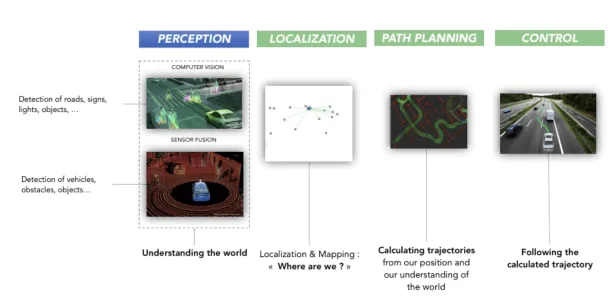
Levels of automation for autonomous vehicles
The spectrum of automation may vary between vehicles. It can be human-assisted partial automation or full automation, depending on technology. Below are graphs that show levels of driving automation and how much human interaction is needed for each level.
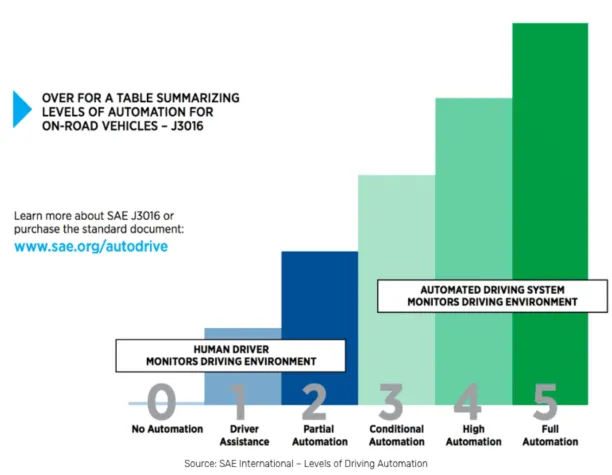
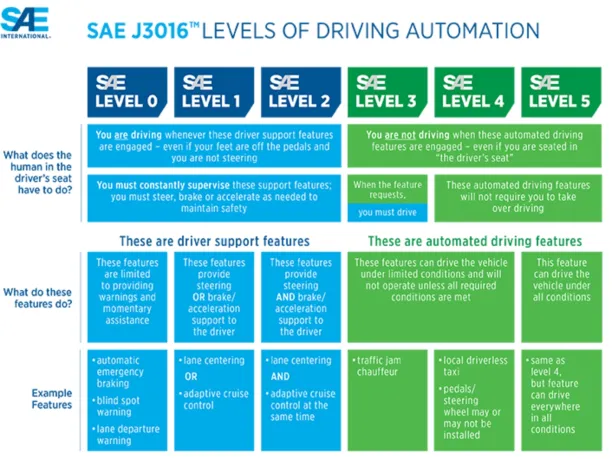
What are the current use cases?
Transportation
- Robo-taxis: Tesla expects to launch robotaxis for an autonomous ride-sharing network, which may change the ownership of cars. Elon Musk said about robotaxis in 2019 Tesla Autonomy Day, “I feel very confident predicting that there will be autonomous robotaxis from Tesla next year — not in all jurisdictions because we won’t have regulatory approval everywhere.” Even though we know that Elon Musk tends to overpromise delivery time from the previous Tesla launches (Model X was launched 2 years late than expected), Tesla tends to eventually deliver. Elon Musk claims that Tesla will have more than one million robotaxis on the road next year.
- Vehicle Platooning: Peloton is using swarm intelligence, the collective intelligent behavior of decentralized systems, to build collaboration among vehicles. Platooning involves a group of self-driving trucks that move at high speed safely and efficiently because each truck communicates with other trucks and adapts its speed and braking accordingly.
- Autonomous shuttles: These vehicles navigate autonomously at sub-50km/h speeds along predetermined, learned paths. Compared to other applications of self-driving cars, autonomous shuttles are easier to regulate thanks to their restricted operations. For instance, EasyMile, an autonomous vehicle company, has deployed their autonomous shuttle EX10 in 300+ locations in more than 30 countries as of 2021. Another example of autonomous shuttles is from Mayo Clinic, a healthcare provider, they use autonomous shuttles to transport medical supplies and COVID-19 tests.
Military
- Military drones: Autonomous military drones can collect real-time intelligence and support decision making. Drones are also capable of carrying weapons and today they are remotely controlled when it is time to make decisions involving use of lethal weapons.
- Lethal autonomous weapons (LAWs): Even though this is a topic of research, LAWs are not in use or at least their use is not public yet. There are different opinions regarding the ethics of using lethal drones in the military. Some support autonomous drones’ military usage while others are against it. Supporters claim that the judgment of machines is not blurry due to a lack of emotions like fear and rage. It is argued that autonomy can reduce war crimes because drones provide more accurate information which can help differentiate civilians from enemy troops. Opponents including numerous Nobel laureates claim that LAWs make wars easy to start and perpetuate.
Retail
- Autonomous shops: Shops like Amazon Go are enabling customers to purchase without cashiers or checkout. These shops are expanding across the United States. Two tech start-ups, AiFi and Grabango, are autonomous shopping technology providers that aim to ease shopping with self-checkout systems.
Construction
- Autonomous Cranes: Intsite is a heavy machinery company that launched an autonomous crane product, AutoSite100. The product enables the autonomous operation of heavy-duty machinery using AI and machine vision technology.
- Haulage Vehicles: Komatsu American Corp. announced FrontRunner autonomous haulage system in 2018. The product enables mine-wide optimization and safety in the mining industry. It has achieved two billion tons of surface material moved in driverless operation.
Healthcare
- Surgical Robots: SARAS is working on a smart autonomous robotic assistant surgeon that will enable a single surgeon to execute operations. SARAS is a cognitive supervisor system able to infer the actual state of the surgical procedure from the sensing system and to act accordingly with the surgeon’s needs.
- On-demand healthcare: Swoop Aero provides medicine across countries via drones. Swoop Aero’s goal is to access places where the ground transfer is not possible, safe, reliable, or sustainable.
- Search and Rescue: Delft University of Technology is working on ambulance drone technology that helps extend emergency infrastructure to increase rescue rates in disaster sites.
Other
- Security: Sunflower Labs is a home security company that uses autonomous drone systems to scan suspicious activity. It uses AI-powered activity detection to alert homeowners and help file a police report.
- Surveying: Airobotics provides an industrial-grade, on-site, fully autonomous drone solution. Organizations can make improvements in stockpile management, security inspection, and surveying operations.
- Monitoring almost extinct species: Researchers at the Liverpool John Moores University are working on an autonomous drone system that can follow endangered species and collect information about their health for researchers.
- Weather forecasting: Water-based unmanned surface vehicles (USVs) such as Saildrone can obtain data from the ocean surface. With collected oceanic and atmospheric data, weather analysts can make better forecasting.
What are the challenges facing autonomous things?
We have explained how the autonomous thing is a hot topic with great business potential. Then why don’t we see these vehicles and drones everywhere?
Environmental conditions such as road, weather, and traffic are critical for autonomous vehicles and drones. These technologies perceive their surroundings with sensors that need to be working faultlessly during each condition.
Another raising question about self-driving cars is who will be responsible in case of an accident.
With fully autonomous vehicles, the software and vehicle manufacturers are expected to be liable for any at-fault collisions (under existing automobile products liability laws) but its ethical values are still a debate topic.
For example, Volvo has already announced that it will pay for any injuries or damage caused by its fully autonomous car, which it expects to start selling in 2020.
Cybersecurity is another issue. Designing secure systems is a problem that autonomous vehicles must solve.
Drone robots have different regulations that limit their areas of activity until regulators agree that the technology is ready for real-world conditions. For example, there is a policy in each state of the US that permits robots under a certain weight (50kg) to operate autonomously. Also, drones can’t fly without a remote pilot in populated areas because of both tech limitations and legal ambiguity regarding responsibility for the actions of an autonomous drone.
What are the leading companies in Autonomous Things?
Autonomous Vehicles Companies
- Argo AI
- Aptiv
- Baidu
- BMW
- Derq
- Ford
- GM Cruise
- Tesla
- Volvo and Waymo (in 2020, the companies reached an agreement whereby Waymo would provide Volvo with its AI software).
Tesla is one of the leading companies in the autonomous vehicles market with $6.35 B in revenue. Der is also another company in the market, it has SXSW award-winning algorithms that analyze roadside sensor data in real-time to predict dangerous situations with enough time to warn drivers.
Drones
- 3DR
- Airdata UAV
- Airmap
- DJI Innovations
- Juniper Unmanned
- Percepto
- Skycatch
- SolSpec
DJI Innovations is the leading company in the market possessing approximately 70% of the global enterprise drone market and it has a total of $1.1B in funding.
Feel free to check our other AI-related articles.
If you have any questions, contact us:
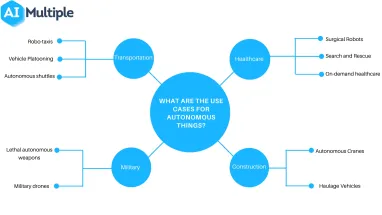
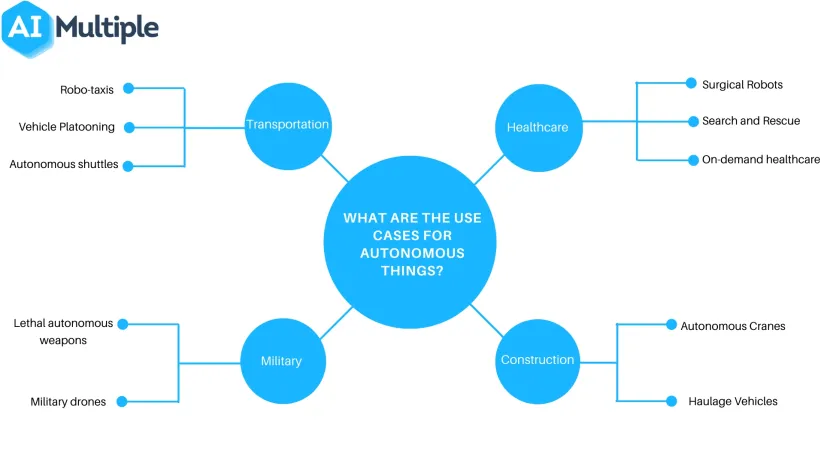

Comments
Your email address will not be published. All fields are required.